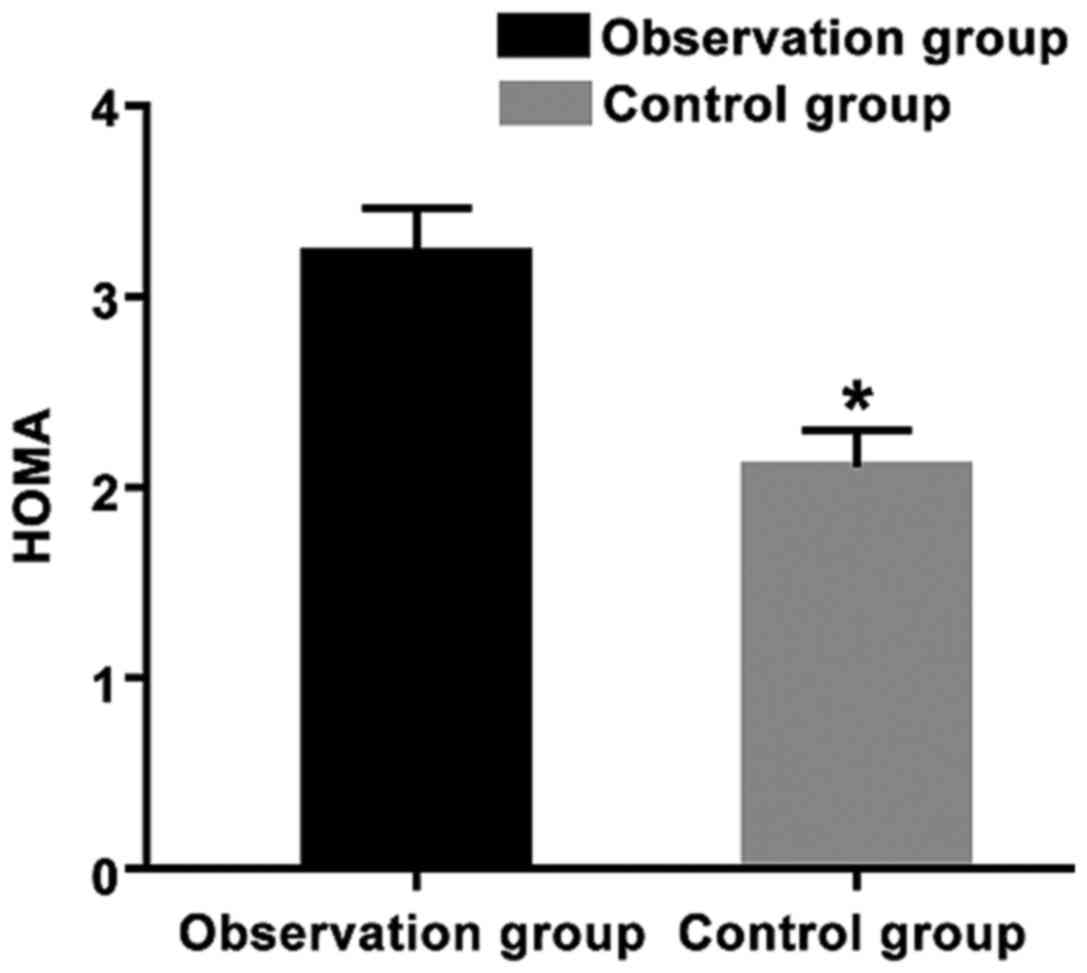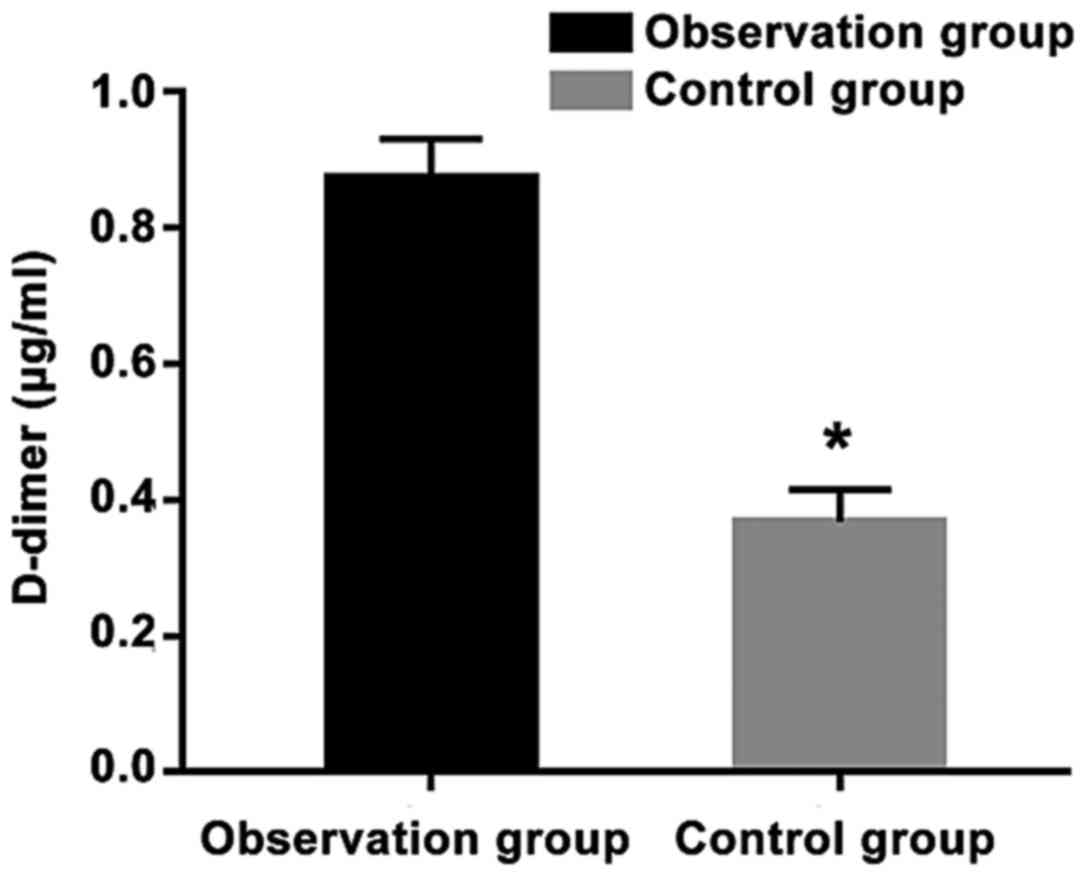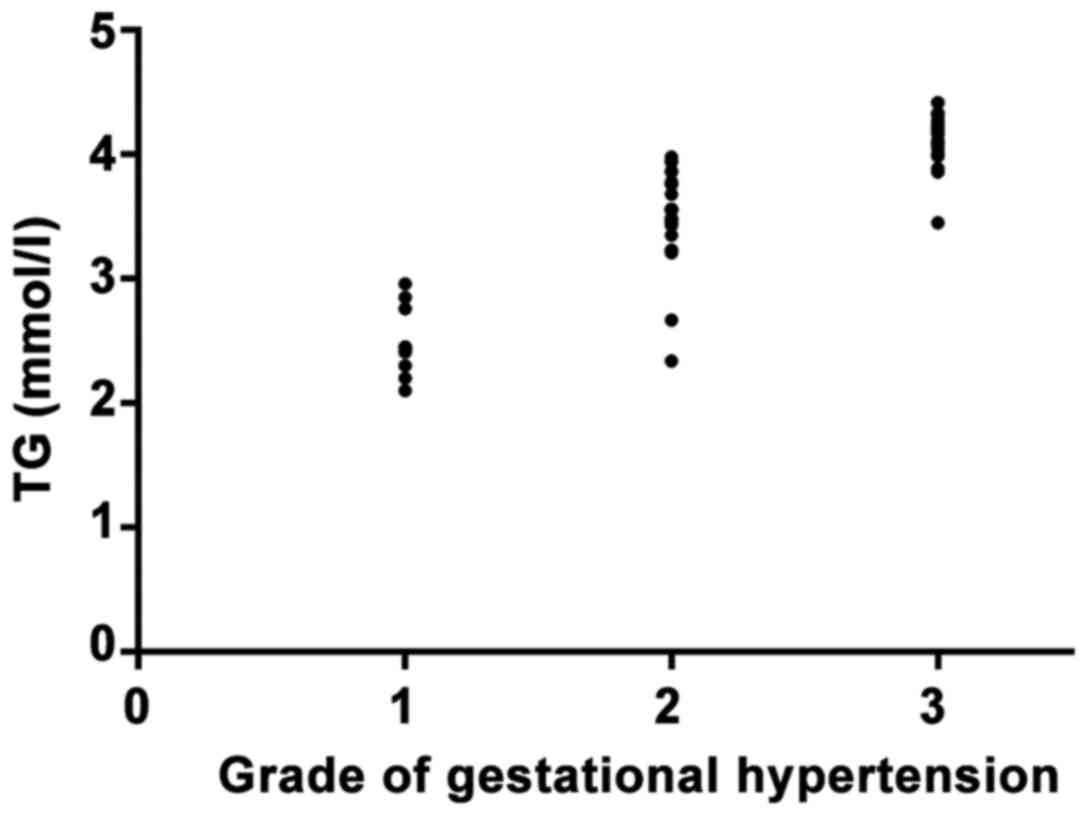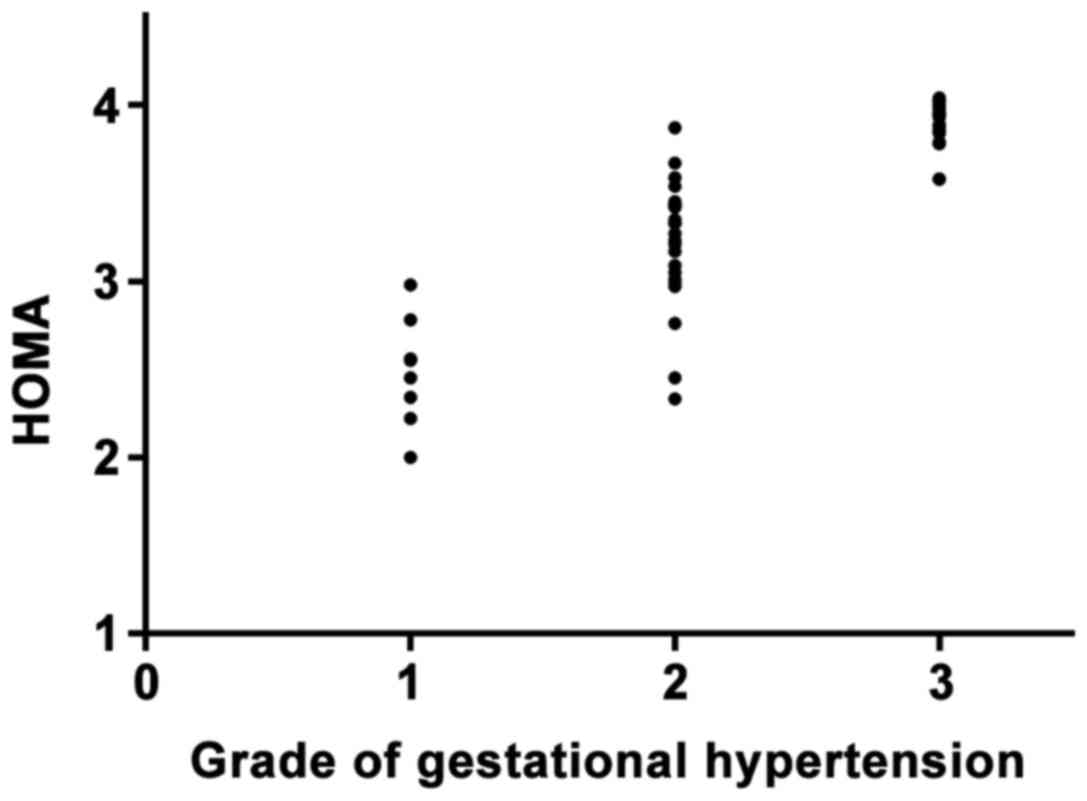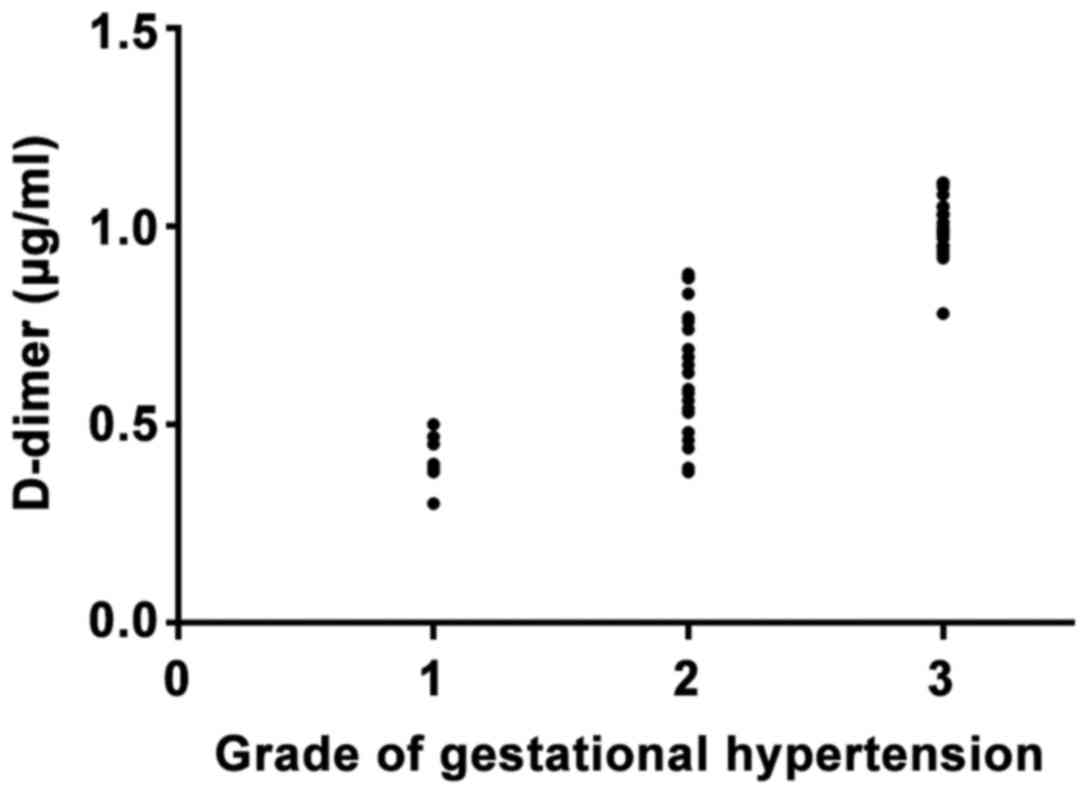Correlation of gestational hypertension with abnormal lipid metabolism, insulin resistance and D-dimer and their clinical significance
- Authors:
- Published online on: December 7, 2018 https://doi.org/10.3892/etm.2018.7070
- Pages: 1346-1350
-
Copyright: © Jin et al. This is an open access article distributed under the terms of Creative Commons Attribution License.
Abstract
Introduction
Gestational hypertension is an obstetrical and gynecological disease with a high morbidity rate, and its onset often brings serious consequences to patients, such as eclampsia, dyspnea and abortion. If timely diagnosis and treatment are not received, it can even be life-threatening (1,2). As the mechanism has been far from explicated, there are still many difficulties in treatment (3,4). It is found clinically that the onset of gestational hypertension has a good correlation with vascular endothelial injury, the latter of which is also closely related to hyperlipidemia, suggesting that there is a correlation between abnormal lipid metabolism and gestational hypertension (5–7).
Metabolic diseases are usually manifested as abnormal insulin resistance, and gestational hypertension is also a kind of metabolic disease, thus there are possibly a number of changes in its insulin resistance (8). Blood coagulation and fibrinolysis are common manifestations in patients with gestational hypertension and such physical changes have a great relation with D-dimer, which can be used to deduce the function of D-dimer in gestational hypertension. Therefore, the treatment and prevention of gestational hypertension can be achieved by controlling the D-dimer (9). A total of 73 patients with gestational hypertension and 70 healthy subjects were selected into the study, and the abnormal lipid metabolism, insulin resistance and D-dimer in the two groups were compared. The correlations of gestational hypertension with the above-mentioned indexes were analyzed in order to provide more therapeutic targets for gestational hypertension.
Patients and methods
General data
A total of 73 patients with gestational hypertension in Jinhua People's Hospital (Jinhua, China) from December 2016 to December 2017 were selected and divided into the observation and control groups. Patients in the observation group (aged 27.3±2.6 years, gestational weeks 35.3±3.4 weeks, pre-pregnant body mass index BMI 22.34±2.8 kg/m2) and the subjects in the control group (aged 28.9±2.8 years, gestational weeks 34.5±3.3 weeks, pre-pregnant BMI 23.09±2.4 kg/m2) were primiparae. Inclusion criteria: patients with gestational hypertension conforming to the diagnostic criteria of gestational hypertension specified in the 8th edition of Obstetrics and Gynaecology and patients without serious injury in the heart, liver and kidney. Exclusion criteria: patients with poor compliance and unable to cooperate with the diagnosis of doctors, patients with other metabolic diseases affecting insulin resistance, or patients with lipid metabolic disease.
The study was approved by the Ethics Committee of Jinhua People's Hospital and informed consents were signed by the patients or guardians.
Classification of gestational hypertension
Based on the classification methods in the 8th edition of Obstetrics and Gynaecology, gestational hypertension was divided into three grades (mild, moderate and severe). Mild: patients have no obvious physical discomfort and slight discomfort will disappear naturally after several days. Moderate: patients suffer from hypertension and edema. Severe: patients have various adverse reactions, such as nausea, tachypnea, chest stuffiness, diastolic blood pressure >14.7 kPa and systolic blood pressure >21.3 kPa.
Indexes of lipid metabolism
The levels of triglyceride (TG), total cholesterol (TC), high-density lipoprotein cholesterol (HDL-C) and low-density lipoprotein cholesterol (LDL-C) were detected with a full-automatic biochemical analyzer. HDL-C was detected via shielded method and other indexes were detected via enzyme assay.
Insulin resistance index
The level of fasting insulin (FINS) was detected with a FINS kit, the level of fasting blood glucose (FBG) was detected via glucose oxidase method. Then HOMA index was calculated using the levels of FINS and FBG.
Detection of D-dimer
The fasting venous blood was extracted from the pregnant woman and then the upper-layer serum was taken for centrifugation at 3,000 × g for 5 min. The level of D-dimer in plasma was detected within 2 h via immunoturbidimetry.
Statistical analysis
Statistical Product and Service Solutions (SPSS) 17.0 software (SPSS, Inc., Chicago, IL, USA) was used for data statistics and analysis. t-test was used for the difference comparison between the two groups (measurement data). Chi-square test was used for the difference comparison of enumeration data. Pearson's method was used for correlation analysis. P<0.05 was considered to indicate a statistically significant difference.
Results
Comparison of general data between two groups
Patients in the observation group (aged 27.3±2.6 years, gestational weeks 35.3±3.4 weeks, pre-pregnant BM 22.34±2.8 kg/m2) and the subjects in the control group (aged 28.9±2.8 years, gestational weeks 34.5±3.3 weeks, pre-pregnant BMI 23.09±2.4 kg/m2) were primiparae. There were no significant differences in any of these indexes (Table I).
Comparison of lipid metabolism indexes between two groups
The level of HDL-C in control group was significant higher than that in the observation group, while the levels of other indexes were all lower than those in the observation group (P<0.05), and the differences were statistically significant (Table II).
Comparison of insulin resistance between two groups
HOMA index in the observation group was significantly higher than that in the control group (P<0.05), and the difference was statistically significant (Fig. 1).
Comparison of D-dimer between two groups
The level of D-dimer in the observation group was significantly higher than that in the control group (P<0.05) (Fig. 2).
Correlation analysis of TG and the grade of gestational hypertension
In the correlation analysis of TG and the grade of gestational hypertension, it was found that TG was positively correlated with gestational hypertension (r=0.8767, P<0.01) (Fig. 3).
Correlation analysis of HOMA and the grade of gestational hypertension
The correlation analysis of HOMA and the grade of gestational hypertension demonstrated that HOMA was positively correlated with gestational hypertension (r=0.8819, P<0.01) (Fig. 4).
Correlation analysis of D-dimer and the grade of gestational hypertension
In the correlation analysis of D-dimer and the grades of gestational hypertension, it was revealed that D-dimer was positively correlated with gestational hypertension (r=0.8933, P<0.01) (Fig. 5).
Discussion
The morbidity rate of gestational hypertension is higher among women during pregnancy, and if timely treatment is not received, severe consequences will be caused, such as placental abruption, shock and even death (10). Though great attention has been put on gestational hypertension in clinic, its mechanism has not been fully investigated. Therefore, there are considerable difficulties in treatment (3,11).
Clinically, gestational hypertension is considered to be correlated with endothelial injury. The more severe the injury is, the higher the morbidity rate of gestational hypertension will be. As abnormal lipid metabolism often leads to vascular endothelial cell damage, it can be considered that there is a correlation between abnormal lipid metabolism and gestational hypertension (12,13).
In this study, it was found that the level of HDL-C in the observation group was significantly lower than that in the control group (P<0.05), while the levels of other indexes were all significantly higher than those in the control group. Moreover, gestational hypertension was found to be positively correlated with TG, suggesting that the morbidity rate of gestational hypertension will increase with the increased level of TG. Intestinal absorption capacity of pregnant women will increase during pregnancy, especially the absorption of fat, which may lead to the increased levels of TG and TC in pregnant women.
In case of excessive increase, severe endothelial cell damage will be caused, leading to gestational hypertension. Besides, the level of HDL-C in the observation group was found to be significantly lower than that in the control group during the investigation, suggesting that the level of TG is very high in body and its synthetic process is highly active, thus inhibiting the histolysis function of surrounding tissues. In addition, the level of LDL-C in the observation group was significantly higher than that in the control group. When there is excessive LDL-C, part of LDL-C is converted to oxidized LDL-C, which brings a series of consequences, such as serious injury to endothelial cells, higher cell permeability, more release of endothelin, higher blood pressure and even intravascular coagulation (14,15).
In this study, the HOMA index in the observation group was significant higher than that in the control group (P<0.05) and HOMA was positively correlated with gestational hypertension. Insulin resistance refers to the decrease in the sensibility of tissues and muscles in body to insulin, which results in such symptoms as lower sugar tolerance and abnormal lipid metabolism. In this case, the conversion of glucose to TG is promoted and the level of free fatty acid is increased, thus, causing abnormal lipid metabolism (16,17).
Patients with gestational hypertension usually have symptoms of spasm, blood coagulation and fibrinolysis, which result in thrombus, seriously threatening the health of patients and fetuses. Therefore, the occurrence of blood coagulation should be reduced in treatment. D-dimer is the representative factor of hyperfibrinolysis and its increase indicates that fibrinolysis system activity is abnormal and the fibrinolysis function is reduced (18,19). Moreover, the level of D-dimer in the observation group was found to be significantly lower than that in the control group in the study, and it was increased with the exacerbation of the disease.
In conclusion, patients with gestational hypertension are found to have abnormal lipid metabolism, higher insulin resistance (HOMA) and significant higher D-dimer. Gestational hypertension is positively correlated with TG, HOMA and D-dimer. It is suggested that more attention should be paid to the detection of the above-mentioned indexes in the treatment and prevention of gestational hypertension, and preventive measures should be enhanced once these indexes are found to be abnormal.
Acknowledgements
Not applicable.
Funding
No funding was received.
Availability of data and material
All data generated or analyzed during this study are included in this published manuscript. The datasets used and/or analyzed during the current study are available from the corresponding author on reasonable request.
Authors' contributions
YJ wrote the manuscript. YJ and MW recorded and analyzed indexes of lipid metabolism. HX and BY interpreted indexes of lipid metabolism. MZ and YZ helped with insulin resistance index. JW detected D-dimer. All authors read and approved the final manuscript.
Ethics approval and consent to participate
The study was approved by the Ethics Committee of Jinhua People's Hospital (Jinhua, China) and informed consents were signed by the patients or guardians.
Patient consent for publication
Not applicable.
Competing interests
The authors declare that they have no competing interests.
References
|
Sibai BM: Diagnosis and management of gestational hypertension and preeclampsia. Obstet Gynecol. 102:181–192. 2003. View Article : Google Scholar : PubMed/NCBI | |
|
Wang YA, Chughtai AA, Farquhar CM, Pollock W, Lui K and Sullivan EA: Increased incidence of gestational hypertension and preeclampsia after assisted reproductive technology treatment. Fertil Steril. 105:920–926.e2. 2016. View Article : Google Scholar : PubMed/NCBI | |
|
Zeng L, Yang K and Ge J: Uncovering the pharmacological mechanism of astragalus salvia compound on pregnancy-induced hypertension syndrome by a network pharmacology approach. Sci Rep. 7:168492017. View Article : Google Scholar : PubMed/NCBI | |
|
Liang C, Wang J, Xia X, Wang Q, Li Z, Tao R, Tao Y, Xiang H, Tong S and Tao F: Serum cobalt status during pregnancy and the risks of pregnancy-induced hypertension syndrome: A prospective birth cohort study. J Trace Elem Med Biol. 46:39–45. 2018. View Article : Google Scholar : PubMed/NCBI | |
|
Long ML, Xia AB, Cheng CX and Li RZ: Therapeutic effect of hemin on gestational hypertension in rats and the mechanism. Nan Fang Yi Ke Da Xue Xue Bao. 35:583–586. 2015.(In Chinese). PubMed/NCBI | |
|
Wang JX, Knottnerus AM, Schuit G, Norman RJ, Chan A and Dekker GA: Surgically obtained sperm, and risk of gestational hypertension and pre-eclampsia. Lancet. 359:673–674. 2002. View Article : Google Scholar : PubMed/NCBI | |
|
Roberts JM, Bodnar LM, Lain KY, Hubel CA, Markovic N, Ness RB and Powers RW: Uric acid is as important as proteinuria in identifying fetal risk in women with gestational hypertension. Hypertension. 46:1263–1269. 2005. View Article : Google Scholar : PubMed/NCBI | |
|
Guo J, Liu G and Guo G: Association of insulin resistance and autonomic tone in patients with pregnancy-induced hypertension. Clin Exp Hypertens. Nov 27–2017.(Epub ahead of print). | |
|
Ai L, Lan X, Wang L, Xu Y and Zhang B: Clinical study on the influence of phloroglucinol on plasma angiotensin II and D-Dimer index in patients with severe pregnancy-induced hypertension. Pak J Pharm Sci. 29 Suppl 4:1375–1378. 2016.PubMed/NCBI | |
|
Saraswat L and Bhattacharya S, Maheshwari A and Bhattacharya S: Maternal and perinatal outcome in women with threatened miscarriage in the first trimester: A systematic review. BJOG. 117:245–257. 2010. View Article : Google Scholar : PubMed/NCBI | |
|
Zhang W, Yuan W, Xu N, Li J and Chang W: Icariin improves acute kidney injury and proteinuria in a rat model of pregnancy-induced hypertension. Mol Med Rep. 16:7398–7404. 2017. View Article : Google Scholar : PubMed/NCBI | |
|
Yang LG, Song ZX, Yin H, Wang YY, Shu GF, Lu HX, Wang SK and Sun GJ: Low n-6/n-3 PUFA ratio improves lipid metabolism, inflammation, oxidative stress and endothelial function in rats using plant oils as n-3 fatty acid source. Lipids. 51:49–59. 2016. View Article : Google Scholar : PubMed/NCBI | |
|
Yu JE, Han SY, Wolfson B and Zhou Q: The role of endothelial lipase in lipid metabolism, inflammation, and cancer. Histol Histopathol. 33:1–10. 2018.PubMed/NCBI | |
|
Kawai T, Ng MC, Hayes MG, Yoshiuchi I, Tsuchiya T, Robertson H, Cox NJ, Polonsky KS, Bell GI and Ehrmann DA: Variation in the perilipin gene (PLIN) affects glucose and lipid metabolism in non-Hispanic white women with and without polycystic ovary syndrome. Diabetes Res Clin Pract. 86:186–192. 2009. View Article : Google Scholar : PubMed/NCBI | |
|
Christoffersen C, Jauhiainen M, Moser M, Porse B, Ehnholm C, Boesl M, Dahlbäck B and Nielsen LB: Effect of apolipoprotein M on high density lipoprotein metabolism and atherosclerosis in low density lipoprotein receptor knock-out mice. J Biol Chem. 283:1839–1847. 2008. View Article : Google Scholar : PubMed/NCBI | |
|
Sun X, Zhang R, Jiang F, Tang S, Chen M, Peng D, Yan J, Wang T, Wang S, Bao Y, et al: Common variants related to serum uric acid concentrations are associated with glucose metabolism and insulin secretion in a Chinese population. PLoS One. 10:e01167142015. View Article : Google Scholar : PubMed/NCBI | |
|
Medina-Urrutia A, Posadas-Romero C, Posadas-Sánchez R, Jorge-Galarza E, Villarreal-Molina T, González-Salazar MC, Cardoso-Saldaña G, Vargas-Alarcón G, Torres-Tamayo M and Juárez-Rojas JG: Role of adiponectin and free fatty acids on the association between abdominal visceral fat and insulin resistance. Cardiovasc Diabetol. 14:202015. View Article : Google Scholar : PubMed/NCBI | |
|
Wada T, Gando S, Maekaw K, Katabami K, Sageshima H, Hayakawa M and Sawamura A: Disseminated intravascular coagulation with increased fibrinolysis during the early phase of isolated traumatic brain injury. Crit Care. 21:2192017. View Article : Google Scholar : PubMed/NCBI | |
|
Tanaka K, Kobayashi Y, Dozono K, Shibuya H, Nishigaya Y, Momomura M, Matsumoto H and Iwashita M: Elevation of plasma D-dimer levels associated with rupture of ovarian endometriotic cysts. Taiwan J Obstet Gynecol. 54:294–296. 2015. View Article : Google Scholar : PubMed/NCBI |



